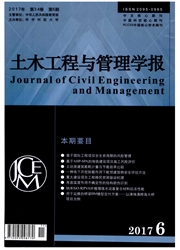

 中文摘要:
中文摘要:
在埋地管道抗震规范法的基础上提出改进,考虑了管土之间的弹塑性滑移,并推导了埋地管道在地震作用下最大反应的解析表达式。运用ANSYS建立了地下管线在地震作用下的有限元模型,合理运用接触单元真实地模拟了管土之间的相互作用,并计算了埋地管道在给定地震作用下的响应时程,从而得到管道的最大轴向应力。通过工程实例比较了抗震规范法、改进的抗震规范法以及有限元法计算埋地管道最大地震响应的优缺点。研究结果表明,改进的规范法的计算结果与相对精确的有限元法的计算结果相近,说明改进的规范法简单实用,且能满足一定的精度要求。
 英文摘要:
英文摘要:
Considering the elastoplasticity slippage between pipe and soil, improvement was proposed based on the seismic code for buried pipeline, and the analytical expression of the maximum response of the buried pipeline was derived. The finite element model of the buried pipeline under earthquake effect was built by the ANSYS, the contact element was reasonably used to imitate the pipe-soil interaction veritably, and the response time history of the buried pipeline under a given earthquake effect was calculated, so the biggest axial stress was obtained. The advantages and disadvantages of the seismic code method, improved seismic code method and finite element method calculating the maximal seismic response were compared according to an engineering example. The results of the study indicate that the results of the improved seismic code method are more close to relatively accurate finite element method, this shows that improved seismic code method is not only simple and practical, but also satisfing certain accuracy, it is very feasible, accurate and efficient when a large number of analysis for the seismic response of the buried pipelines are doing.
 同期刊论文项目
同期刊论文项目
 同项目期刊论文
同项目期刊论文
 期刊信息
期刊信息
